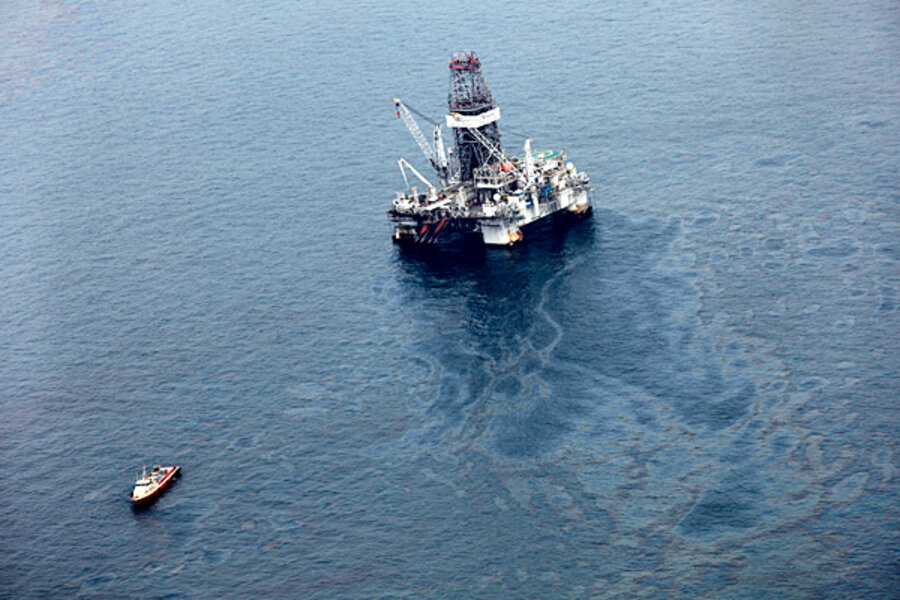What BP's partners are doing in Gulf oil spill cleanup
Loading...
BP has taken responsibility for the Gulf oil spill and is leading the cleanup effort. But a kaleidoscope of different companies was working on the Deepwater Horizon rig when it exploded April 20 and could be held legally at fault in the future.
What role are they playing in the cleanup?
Here is a look at what they are doing:
RELATED: Should other firms in Gulf oil spill blame game be helping BP?
Transocean
Transocean, which is based in Switzerland, owned the Deepwater Horizon oil rig. Transocean has three ships, the Discoverer Enterprise and Development Driller II and III, which, according to fleet update reports on the company’s website, are charging a combined $1.5 million per day to BP to assist with spill-stopping efforts.
The Discoverer Enterprise is currently collecting about 630,000 gallons of oil a day from the well. The Development Drillers II and III are drilling the relief wells thought to be the only means of permanently plugging the well.
The three vessels were all under contract with BP prior to the Deepwater Horizon’s rig explosion, says company spokesman Guy Cantrell, who adds that he does not believe the terms of those contracts have changed since.
Transocean also has around 600 employees both on and offshore who are involved in ending the spill, he says, but declined to say if BP would also be responsible for compensating those employees.
Halliburton
Halliburton was working on cementing the Deepwater Horizon’s oil well about 20 hours prior to the accident.
Since the blowout, the company has provided services including “intervention support to help secure the damaged well and planning and services associated with drilling relief well operations," said President of Global Business Lines Timothy Probert in congressional testimony May 11.
Halliburton has deployed “survey-management experts to assist in planning the path of the relief wells,” he said. In addition, the company is collaborating on “an effort to develop an integrated ranging system to expedite the intersection of the original well,” added Mr. Probert in the testimony.
Halliburton and BP both declined to say whether Halliburton’s work to stop the spill was under contract with BP. Halliburton spokeswoman Teresa Wong also declined to say how many Halliburton employees or how much of the company’s equipment may be being used in stopping the ongoing Gulf catastrophe.
Anadarko Petroleum Corporation
Anadarko Petroleum Corporation and Mitsui Oil Exploration had 25 percent and 10 percent stakes, respectively, in the well.
Anadarko was a non-operating investor of the well with no employees working on the rig and, according to company spokesman John Christiansen, “all questions regarding our liability will be addressed at the appropriate time.”
The company initially released three vessels after the blowout and currently has several of its technical experts assisting with finding a way to stop the leaking well, Mr. Christiansen says. But regarding who is paying for those resources, “we don’t know how it will be worked out eventually,” he says.
He adds that though the company is not presently assisting with oil cleanup, Anadarko has offered its services to the unified command center, and “we stand by ready to do whatever is necessary.”
Officials at Mitsui could not immediately be reached for comment.
Cameron International
Cameron International was the manufacturer of the well’s blowout preventer, the device designed to prevent such spills, but which failed in this case.
Company spokesman Mike Pascale said Cameron had no comment at this point regarding any potential liability, and notes that no employees of the company were working on the rig during the accident.
Cameron employees are in the Gulf assisting with their expertise to stop the oil spill, but Mr. Pascale declined to say how many employees or which company is paying them for their work. Cameron is not assisting with cleanup efforts, he says.
Other companies
Schlumberger Ltd. was contracted by BP and had a crew onboard the Deepwater Horizon to conduct wireline services. That crew left the rig 11 hours prior to the April 20 explosion, according to a statement released by Schlumberger last month.
Additionally, testimony given during May 11 congressional hearings named MI-SWACO as the well’s mud engineer subcontractor, along with Weatherford International Ltd., the casing subcontractor.
Officials at Schlumberger and MI-SWACO could not be reached for comment. Weatherford declined comment.
Of the 126 people working on the Deepwater Horizon, 79 were Transocean employees, six were BP employees, and 41 were contract workers, including four Halliburton employees and five from MI-SWACO.
Related:





